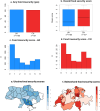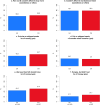The food security of residents and refugees of Ukraine after the Russian invasion
- PMID: 40346166
- PMCID: PMC12064787
- DOI: 10.1038/s41598-025-99285-1
The food security of residents and refugees of Ukraine after the Russian invasion
Abstract
In this paper, survey evidence is used to examine the food security impacts of the 2022 Russian invasion of Ukraine. We focus on both residents of Ukraine and those fleeing to one of the wealthiest countries in Europe, Switzerland. Our questionnaire was sent to both Ukrainian residents and migrants to Switzerland between October 2022 and February 2023. 80% of respondents (n = 1267) indicated that they faced some form of food insecurity, most commonly an inability to eat balanced meals and/or running out of food without being able to buy more. Yet the incidence of more severe forms of food insecurity, including cutting and skipping meals for multiple months, eating less than needed, and feeling hungry without eating, affected more than 20% of the surveyed populations in both countries. Food insecurity for both residents of Ukraine and refugees in Switzerland is significantly more severe for households who perceive themselves to have below average income. In Ukraine higher food insecurity is identified in the conflict's frontline regions and among larger households with less domestic food production. In Switzerland, women report lower access to many coping mechanisms (producing, trading, or borrowing food). This study underscores the urgent need for improved food programs in conflict zones as well as countries that host refugees, particularly where domestic food prices are very high and language barriers reduce income opportunities.
Keywords: Displacement; Migration; Nutrition; War.
© 2025. The Author(s).
Conflict of interest statement
Declarations. Competing interests: The authors declare no competing interests.
Figures



Similar articles
-
The Ukraine-Russia War Is Deepening Food Insecurity, Unhealthy Dietary Patterns and the Lack of Dietary Diversity in Lebanon: Prevalence, Correlates and Findings from a National Cross-Sectional Study.Nutrients. 2022 Aug 25;14(17):3504. doi: 10.3390/nu14173504. Nutrients. 2022. PMID: 36079761 Free PMC article.
-
Barriers to healthcare access and continuity of care among Ukrainian war refugees in Europe: findings from the RefuHealthAccess study.Front Public Health. 2025 Apr 2;13:1516161. doi: 10.3389/fpubh.2025.1516161. eCollection 2025. Front Public Health. 2025. PMID: 40241956 Free PMC article.
-
Household food insecurity, living conditions, and individual sense of security: A cross-sectional survey among Burkina Faso refugees in Ghana.PLoS One. 2025 Jan 16;20(1):e0317418. doi: 10.1371/journal.pone.0317418. eCollection 2025. PLoS One. 2025. PMID: 39820579 Free PMC article.
-
Prevalence, Determinants, and Effects of Food Insecurity among Middle Eastern and North African Migrants and Refugees in High-Income Countries: A Systematic Review.Int J Environ Res Public Health. 2020 Oct 4;17(19):7262. doi: 10.3390/ijerph17197262. Int J Environ Res Public Health. 2020. PMID: 33020437 Free PMC article.
-
One Year On: Poland's Public Health Initiatives and National Response to Millions of Refugees from Ukraine.Med Sci Monit. 2023 Mar 31;29:e940223. doi: 10.12659/MSM.940223. Med Sci Monit. 2023. PMID: 36998206 Free PMC article. Review.
References
-
- UNICEF. The state of food security and nutrition in the world 2021. State Food Secur. Nutr. World SOFI (2021).
-
- Rudolfsen, I., Bartusevičius, H., van Leeuwen, F. & Østby, G. War and food insecurity in Ukraine. World Dev.180, 106647 (2024).
-
- Global Internal Displacement Database (GIDD). Forced migration or displacement. Migration Data Portal (2024).
-
- Carter, B. & Kelly, L. Social inequalities and famine and food insecurity risk. K4D Helpdesk Report. Institute of Development Studies. Inst. Dev. Stud.10.19088/K4D.2021.097 (2021).
-
- UNHCR. Operatational Data Portal. https://data2.unhcr.org/en/situations/ukraine (2024).
MeSH terms
Grants and funding
LinkOut - more resources
Full Text Sources

